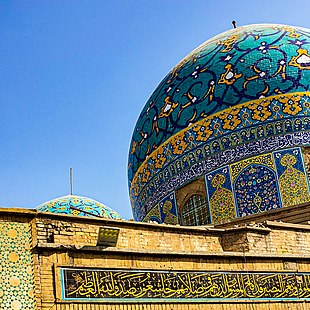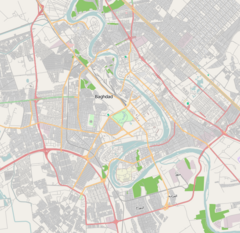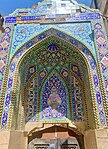Haydar-Khana Mosque
| Haydar-Khana Mosque | |
|---|---|
Arabic: جامع الحيدرخانة | |
 | |
| Religion | |
| Affiliation | Islam |
| Rite | Sunni Islam and Shia Islam |
| Ecclesiastical or organisational status | Mosque and madrasa |
| Status | Active |
| Location | |
| Location | Baghdad, Iraq |
Location in Baghdad | |
| Geographic coordinates | 33°19′30″N 44°25′19″E / 33.32500°N 44.42194°E |
| Architecture | |
| Style | Abbasid architecture |
| Date established |
|
| Specifications | |
| Dome(s) | 3 |
| Minaret(s) | 1 |
The Haydar-Khana Mosque (Arabic: جامع الحيدرخانة) is a historic mosque located near al-Mutanabbi Street[1] in Baghdad, Iraq, built by al-Nasir during the Abbasid Caliphate. The mosque is situated on al-Rashid Street and is located in the Haydar-Khana locality surrounded by buildings, shrines, and cafés.[2][3] The mosque is an important historic landmark that reflect the society of Baghdad, intellectual gatherings, and fueling enthusiasm for demonstrations.[4]
The Mosque is considered one of the most beautiful and perfect mosques in Baghdad in terms of engineering and architectural construction and is also considered important for its contribution to revolutionary ideas against British colonialism of Iraq.[5] It is also a great symbol for Iraqis because it was the center of national events of the religious, political and social diversity of the region.[6]
Historical background
[edit]Construction history and context
[edit]
The Mosque was said to be first originally established and constructed by Abbasid Caliph al-Nasir and its original name is attributed to an old unknown Sufi man named "Haydar."[5] The mosque originally had a Sufi Lodge but it wasn't inside the mosque, instead it on a branch next to the mosque.[7] The name of the mosque later was attributed to a man said to be named "Haydar Pasha Jalabi bin Muhammad Jalabi Shabandar" who's said to be an Iraqi notable who established Hammam Haydar and is buried in the same place along with some members of his family. Although there are many folklore tales over the origin of the name. The mosque was later reconstructed and expanded during 1819–1827 by the Mamluk ruler of Baghdad Dawud Pasha, the last ruler of the Mamluk state of Iraq.[8][9]
Dawud Pasha established a madrasa in the same place, known as Madrasa al-Dawudiyya. There is also an attached library. Reconstruction and maintenance were carried out in 1827 during the reign of the Ottoman Sultan Mahmud II, again in 1890 by the then-Ottoman emir Abdul Hamid II.[9] The square shaped mosque was considered the biggest mosque from the Ottoman era in Baghdad due to its size and area.[10] Among the most well-known teachers who taught at the mosque's madrasa was the Islamic scholar Mahmud al-Alusi in 1905.[11]
The Mosque is situated in the Haydar-Khana neighborhood, located at the beginning of al-Rashid Street near the side of al-Maidan Square.[12]
The Revolutionary Mosque and post independence of Iraq
[edit]The Haydar-Khana Mosque is usually nicknamed the "Revolutionary Mosque" by Iraqis due to its history of revolutionary gatherings and in spreading awareness, calls, and broadcasting of social issues to Iraqis as well as that of the religious and intellectual renaissance. In 1920, the notables of Baghdad gathered in the mosque in what marked the beginning of the Iraqi Revolt. The mosque was also a stage for many personalities who fought against the British Colonel rule including Mulla Uthman al-Mawsili who broadcast his sermons in the mosque, and moved people towards the revolution, as he made the mosque square a site for daily gathering of people and not just a worshipping place.[5][13] The first meeting in the mosque was held in 13 May during the Islamic month of Sha'ban.[14] Notables from as far as Karbala have participated in its gatherings including citizen members of Sayyid Abd al-Razzaq al-Wahaab's membership that ran Karbala at the time.[15] British forces responded by sending troops and armored cars continuously whenever there was a meeting. Violence breaking between the two sides would also lead to the death of at least one Arab Iraqi in the earlier meetings.[16]

The enthusiasm and national spirit was running high during the gatherings, these were noted by Musa al-Shabandar when he visited the mosque during Mawlid. He also noted similar enthusiasm in other mosques celebrating Mawlid at the time such as al-Kadhamiya Mosque. On June 24, 1920, a large demonstration was held in the mosque, where the poet Isa Abd al-Qadir read a poem in which he called for the solidarity and unity of Iraq. As a result, he was arrested by the British forces and exiled to Basra, the people became angry and the shop owners of al-Rashid Street closed their shops in condemnation of his exile.[17]
These gatherings made the area of the mosque extremely crowded. Poets would also recite enthusiastic poems urging participation and confronting the British occupation. British occupation forces and soldiers stormed the mosque many times to arrest some personalities who enjoy a large mass and it caused Iraqis to face the occupation and the soldiers with simple weapons. The mosque remained a gathering ground for demonstrations even after the independence of the Kingdom of Iraq. The mosque was also inhabited by prominent personalities such as Nuri al-Said, al-Rusafi, Mohammed al-Shabibi, al-Zahawi, and Said Qazzaz.[6][18]

An example of a demonstration in the mosque was when Ja'far Abu al-Timman boycotted the Iraqi elections of 1930 in protest against the Anglo-Iraqi Treaty. Al-Timman's political party, al-Hizb al-Watani, marched from their headquarters to the mosque and assembled in it. Later, the police arrived and attempted to arrest and stop the crowd. The leaders of the protest were sentenced to six months in prison while some protestors were given three months. Although cases some were quickly discharged.[19] During demonstrations against the Anglo-Iraqi Treaty of 1948 and British involvement in Iraqi politics, the brother of Iraqi poet al-Jawahiri, Ja'far, was killed in a gunfire on what is now al-Shuhada' Bridge. Forty days after Ja'far's funeral, al-Jawahiri climbed a ladder to the top of the mosque and recited one of the most famous Iraqi poems in Iraqi history before a crowd of thousands during a commemorative ceremony held at the mosque which took place 40 days after his funeral. This led the Haydar-Khana Mosque to become a rally ground against the British again.[4][20] Al-Jawahiri's memorial for his brother at the mosque became a national event at the time.[21]
The mosque was also located next to the gate to al-Mutanabbi Street and the Hajj Khalil Café. Its owner, Hajji Khalil al-Qahwati, prayed in the mosque daily and attended Friday prayers in it.[22] The last renovation and reconstruction of the mosque was in the year 1972. During the reconstruction work, a stone was found on which it was written that a person named Hassan renewed the building of the mosque in 1792.[5] During this period, the Iraqi master calligrapher Hashem Muhammad al-Baghdadi made calligraphy for the mosque.[23]
Post 2003 US-led invasion
[edit]
After the US Invasion of Iraq in 2003, many of the heritage sites and landmarks of Baghdad are currently suffering from neglect and encroachment and the Haydar-Khana Mosque is one of them despite its importance and significant role in Iraqi society. Parts of the mosque have started to fall apart including its outer stripes that include Quranic verses which were made by Hashem Muhammad al-Baghdadi. It is considered one of the greatest losses of Iraqi heritage. The Ministry of Culture, Tourism, and Antiquities has declined to reconstruct and preserve the mosque due to its complex ownership.[5]
In August 2019, controversy surfaced over pictures by the Iraqi makeup artist and model Jehan Hashim that depict her posing inside the mosque. While some Iraqis on social media didn't see the act as controversial, the Sunni Endowment Office announced that it was about to file a complaint against her and would launch an investigation. Stating that "a lawsuit will be filed against her, and that this act is outside the general context, and that mosques are places of worship and not for photography and parade." Hashim, in turn, defended her behavior, stressing that she did not intend to offend but wanted to "show the beauty of mosques in Iraq, whether in the north, south, or Baghdad, to tell those who follow me from other countries that we have beautiful mosques in which we pray, and that security is established in the country, and that mosques are not deserted and are available to everyone who wants to enter them." She also stated "I do not feel that what I did was a mistake, and I was wearing the hijab and a long and modest robe, as I have love for all religions, and I did not expect that my behavior would be disturbing."[24]
Description
[edit]Haydar-Khana Mosque is considered one of the finest examples of the Ottoman constructions in Baghdad, and, in general, one of the most beautiful mosques in Baghdad.[5][9]
Layout and interior
[edit]The mosque is square-shaped, and the three doors are made of marble. Inside the mosque, there are mushollas (prayer spaces) for summer and winter, and the winter chapel is topped by a massive façade blue dome with two smaller domes and a minaret surrounding it.[5][9] The colors of the livery consist of blue and yellow.[2] One of the reasons the mosque is considered fine in its structure is due to its seemingly perfect harmonious proportions as the prayer space is square in shape with the direction of the qibla facing al-Rasheed Street directly. The calligraphy band on the exterior of the complex is made with kashi blue and gold tiles. The western part of the complex includes an iwan which serves as the main entrance to the building.[25]
In front of the winter prayer space, there is a vaulted arcade surmounted by five small domes although three notable ones. This arcade has a large entrance in front of the door of the sanctuary, and to its side are four smaller entrances. The large entrance has a pointed arch that connects from the outside with another pointed arc above it, and between the upper and lower arches are pendants and stalactites in the middle of which is a Qur'anic verse.[26] Taking into account the climatic conditions of the city of Baghdad, the thickness of the walls is 2.5 meters.[27] The Mosque also contains a number of madrasas of Islamic sciences and a library that contains works of the most prominent scholars of the city.[28]
- Exterior details of the mosque
-
The main dome of the mosque which rests on a bricked portico.
-
The gate to the mosque from al-Rasheed Street.
-
Decorations of the gate to the mosque's courtyard.
-
Exterior wall of the mosque that contains calligraphy.
-
Another side of the exterior wall.
Ornaments
[edit]The main big dome, which rests on eight windows that make a cupola, is covered with arabesque motifs and inscriptions decorated using Kashi blue tiles. Inside the building's main cupola is a band of calligraphy under the windows. The minaret of the mosque is covered in kashi tiles and its basin rests on three bands of muqarnas with a blue ribbed dome topping the minaret.[25] Under the big dome in the summer chapel, there's a mihrab made of colored bricks, and on either side of it are panels with pointed arches and writings in square Kufic script. There are also inscriptions that date the construction of the mosque.[26]
- Decorations of the mosque
-
Decorations of the mosque as seen from al-Rashid Street.
-
The only remaining interior decorations of the mosque's dome after decay.
-
View of the main dome of the Haydar-Khana Mosque from the inside.
-
Decorations of the entrance of the Haydar-Khana Mosque
In fiction
[edit]The comic book The Sandman features a story (issue 50, "Ramadan") taking place in Baghdad in which a similar looking mosque can be seen on the seventh page.[29]
The mosque is present in several Arabic novels such as The Traveler and the Innkeeper and Papa Sartre.[30][31]
See also
[edit]References
[edit]- ^ "محمد هاشم الخطاط ثـروة وطنية نـادرة و تجربــة فنيــة رائـــدة". منتديات فخامة العراق (in Arabic). 2018-04-29. Retrieved 2023-06-08.
- ^ a b Marozzi, Justin. Baghdad: City of Peace, City of Blood. Penguin UK, May 29, 2014.
- ^ Omari, Yasin bin Khair (2016). Book of the Goal of Maram, in the History of Mohsen, Baghdad, Dar al-Salam (in Arabic). House of Basra publications.
- ^ a b Jones, Kevin M. (2020-09-01). The Dangers of Poetry: Culture, Politics, and Revolution in Iraq. Stanford University Press. ISBN 978-1-5036-1387-4.
- ^ a b c d e f g "الحيدر خانة تتكسر معالمه ووزارة الثقافة تعلّق بإحباط على إعمار محتضن قادة ثورة العشرين! » وكالة بغداد اليوم الاخبارية". وكالة بغداد اليوم الاخبارية (in Arabic). Retrieved 2023-06-08.
- ^ a b "الحيدر خانة.. ذاكرة دينية ورمزية سياسية بالعراق". www.aljazeera.net (in Arabic). Retrieved 2023-06-08.
- ^ Al-Gillani, Sharaf al-Din (2014). The history of Baghdad hospices and the Sufi sheikhdom in the Ottoman era (in Arabic). House of Scientific Books.
- ^ "الحيدر خانة.. مختلف في تسميتها ومتفق على روعة تراثها". مجلة الشبكة العراقية,IMN Magazine (in Arabic). 2017-10-29. Retrieved 2023-06-09.
- ^ a b c d "Iraq Significant Site 016 - Baghdad - Haydar-Khana Mosque". 2015-07-17. Archived from the original on 2015-07-17. Retrieved 2023-09-06.
- ^ Francis, Bashir Youssef. موسوعة المدن والمواقع في العراق - الجزء الأول [Encyclopedia of cities and sites in Iraq - Part One] (in Arabic). E-Kutub Ltd. ISBN 978-1-78058-262-7.
- ^ Kedourie, Elie (2012-11-12). Arabic Political Memoirs and Other Studies. Routledge. p. 126. ISBN 978-1-136-27585-2.
- ^ الكويتية, جريدة الجريدة (2023-03-23). "ناظم الغزالي... صوت العراق وسفير أغنيته "1-6"". جريدة الجريدة الكويتية (in Arabic). Retrieved 2023-07-09.
- ^ Al-Haydar Khana Mosque in Baghdad(2017)
- ^ Tauber, Eliezer (2013-09-13). The Formation of Modern Iraq and Syria. Routledge. p. 296. ISBN 978-1-135-20125-8.
- ^ "Karbala Center for Studies and Research | Did You Know?". Karbala Center for Studies and Research (in Arabic). Retrieved 2023-09-14.
- ^ ʻAṭīyah, Ghassān (1973). Iraq, 1908-1921: A Socio-political Study. Arab Institute for Research and Pub. p. 316.
- ^ Al-Abadi, Haider (June 2022). "الشاعر الذي ألهب الشعب في جامع الحيدرخانة..صورة ناصعة من الوحدة الوطنية في ثورة العشرين" [The poet who inflamed the people at the Haydar-Khana Mosque... A bright picture of national unity in the 20th revolution]. www.almadasupplements.com. Retrieved 2023-10-30.
- ^ Zangana, Haifa (2001). مفاتيح مدينة [Keys of a city] (in Arabic). E-Kutub Ltd.
- ^ Khadduri, Majid (2019-03-13), "Curriculum Vitae", Law, Personalities, and Politics of the Middle East, Routledge, pp. 17–24, doi:10.4324/9780429052477-3, ISBN 978-0-429-05247-7, retrieved 2023-09-06
- ^ DeYoung, Terri (1998-04-09). Placing the Poet: Badr Shakir al-Sayyab and Postcolonial Iraq. SUNY Press. p. 189. ISBN 978-0-7914-3732-2.
- ^ Bashkin, Orit (November 20, 2008). The Other Iraq: Pluralism and Culture in Hashemite Iraq. Stanford University Press. p. 119. ISBN 9780804774154.
- ^ Al-Qaisi, Hamid. بغداديات (مقهى خليل) ذكريات وانطباعات [Baghdadiyyat (Khalil Coffeehouse) memories and impressions] (in Arabic). ISBN 9789933914301. Retrieved 2023-11-11.
{{cite book}}:|website=ignored (help) - ^ "الخطاط هاشم محمد البغدادي" [Hashem Muhammad al-Baghdadi the Khattat]. Al-Bayan (in Arabic). 2006-09-26. Retrieved 2023-06-08.
- ^ Saif al-Din, Aktham (August 25, 2019). "Controversy over photos of an Iraqi model inside a mosque in Baghdad". alaraby.co.uk.
- ^ a b "Archnet > Site > Jami' Haydar Khanah". www.archnet.org. Retrieved 2023-08-28.
- ^ a b Al-Haydar Khana Mosque in Baghdad, 2017
- ^ Al-Ahmadiyya Mosque in Baghdad, 2017
- ^ Al-Tarfi, Muayad (20 May 2023). "The mosques and churches of Baghdad are begging for their first minarets and bells". independentarabia.com.
- ^ The Sandman No. 50 (June 1993)
- ^ al-Azzawi, Fadhil; Hutchins, William M. (2011). The Traveler and the Innkeeper. American University in Cairo Press. ISBN 978-977-416-462-0. JSTOR j.ctt15m7krb.
- ^ Ali, Badir (2009). Papa Sartre. Oxford University Press. ISBN 978-977-416-298-5.












